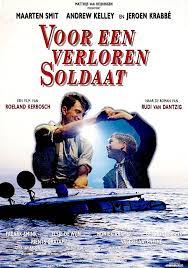
FOR A LOST SOLDIER/ VOR EEN VERLOREN SOLDAAT
Netherlands, 1992, 92 minutes, Colour.
Marteen Smit, Andrew Kelley, Jeroen Krabbe.
Directed by Roeland Kerbosch.
This film is a memoir of World War II, the German occupation of Holland, the transporting of children from Amsterdam to foster care in the countryside. It opens in 1944, establishes the group of children, their being transported, the adoptive families and welcoming them into their households. The action then moves to 1945, the retreat of the Germans, the arrival of the Americans, liberation. It is the story of Rudi van Dantsig, who wrote his story as a novel, contributed to the screenplay. And it incorporates some of the experiences of the director. Rudi van Dantsig was 11 and 12 at this time, the director was four.
The key theme that put this film into the spotlight was the relationship between an occupying American soldier and the 12-year-old boy. The IMDb describes the film as “touching”. Reviews of the time praise the film for its sensitivity. In fact, it is helpful to look at the variety of comments from the bloggers on the IMDb, most of the comments coming eight years and more after the release of the film. There is praise again of its observation of the situation, the emotions of the characters, especially the boy, praise for the lack of explicit moral judgements about the relationship.
Reviews by critics at the time praise the film.
It has been remarked that the film could not be made like this now.
The chief reason for this is the change of public awareness from the early 1990s to the present, more open discussion about paedophilia, the criminal aspects of paedophilia, legislation about age of consent, prosecution of adults who engage in sexual relationships with underage children, the issue of ability for adult consent by underage children, jail sentences. There has been a strong shift in public awareness and public opinion since the 1990s.
Bypassing, for the moment, the central issue, the film is an interesting and strong presentation of occupied Holland, citizens in Amsterdam and the lack of food, the movement (as in Britain and other countries) of children to the countryside, welcoming families, healthy activity and food, school and church. Church is important in this film, the local pastor, the local teacher, church attendance, reading the Bible. There is work to be done, the city children wanting to escape at first, but becoming involved, the central character here, Jeroen helping with the birth of a calf. On the whole, life in occupied Holland seems quite proper – but suggestions of broader issues with one of the refugees, 15-year-old Jan, with some 15-year-old preoccupations with sex.
With the coming of the Americans, and the sense of liberation, the locals respond to the American presence, a concert with a ventriloquist, a singing group, two of the Americans in drag, then the dancing, jitterbugs, and, before long, the roving eye of the Americans and the response of some of the local girls.
But at the centre of the film is Jeroen, played by Marteen Smit in his sole film performance. He has something of a commanding screen presence simply by being there. The film prepares the audience for the sexual issues by a range of sequences, Jan and Jeroen finding a crashed plane in the waters, stripping off to swim out, some sunbaking, gentle references, at home Jeroen having a bath and getting out of the bath… And, there is the suggestion of Jeroen’s curious attraction to Jan and observing him.
The key American is Walt Cook, played by Andrew Kelley in his only film, who takes a shine immediately to Jeroen, spending time with him, giving him sweets, driving around, going to the wreck, letting him drive the Jeep, talking with, increasing intimacy, the audience sensing the emotional and physical attraction, the gay sensibility, and Walt’s story about his growing up, distance from family, and leaving America, the comfortable response by Jeroen and his wanting to be with Walt. This is grooming.
There is a strong scene of intimacy, in Walt’s room, the two naked, on Walt’s bed, and, something that reviewers and bloggers do not mention, the pained look on Jeroen’s face, some tears, during the penetration sequence. However, Jeroen seems to overcome the pain and becomes ever more devoted to Walt.
As said, public sensibilities watching this film in the early 1990s, were not concentrating on issues of underage sexual relationships (or if this was considered, it was considered emotionally favourably). And, as has been said, in recent years, Walt would have been charged with sexual assault of a minor.
Walt disappears, there are happy memories of a photo, and Jeroen’s mother comes to take him away, and a reminder have how welcoming the foster family, parents and children, was.
But there is a framework to the whole film, Jeroen decades later, a choreographer, rehearsing his troupe, dissatisfied with them, talking about themes of freedom and expression. When this is introduced, Jeroen has memories of the past, meetings his younger self momentarily, then the bulk of the film the flashback story. There is a final meeting between the older and younger, then Jeroen the choreographer having some success with his troupe, and, his assistant finding the photo as well is a photo of Walt’s identity tags. Jeroen has no regrets about the past, only the disappearance of Walt.
A comparison might be made with the 1991 American telemovie, Bump in that Night, with Christopher Reeve playing an English professor who befriends a little boy, enjoying his company – the screenplay helping audiences understand paedophile emotions and attractions.
For a Lost Soldier is readily available on YouTube. As is Bump in the Night.